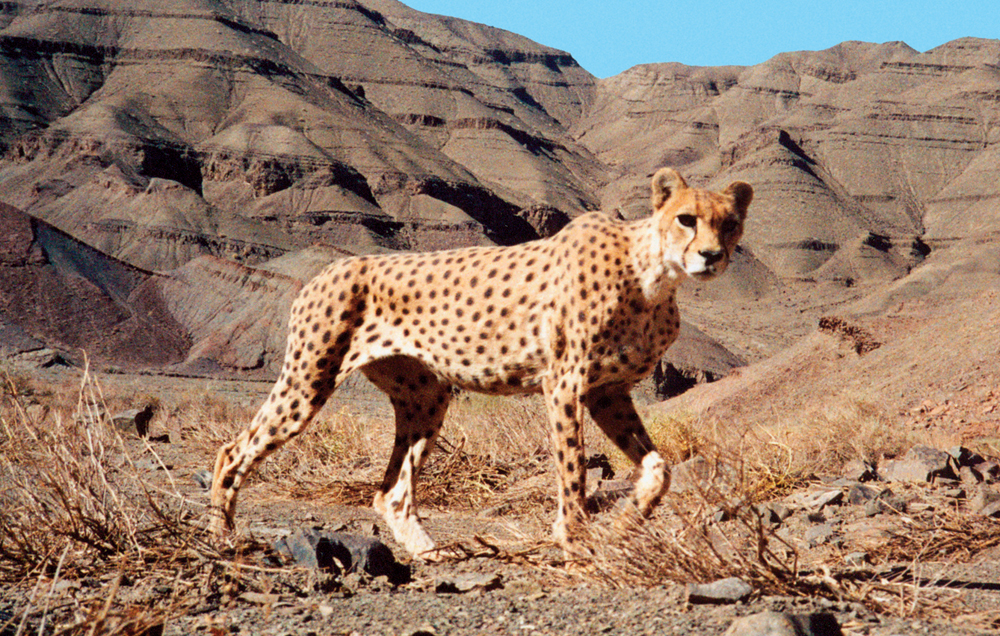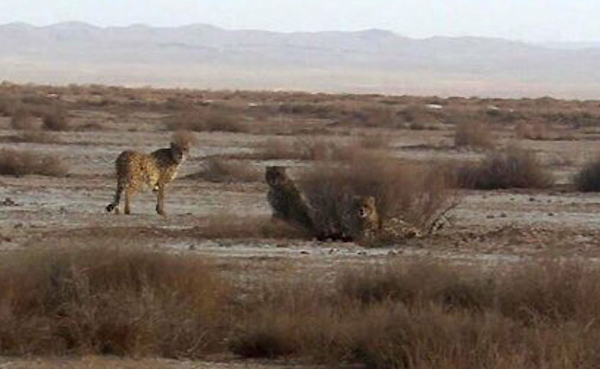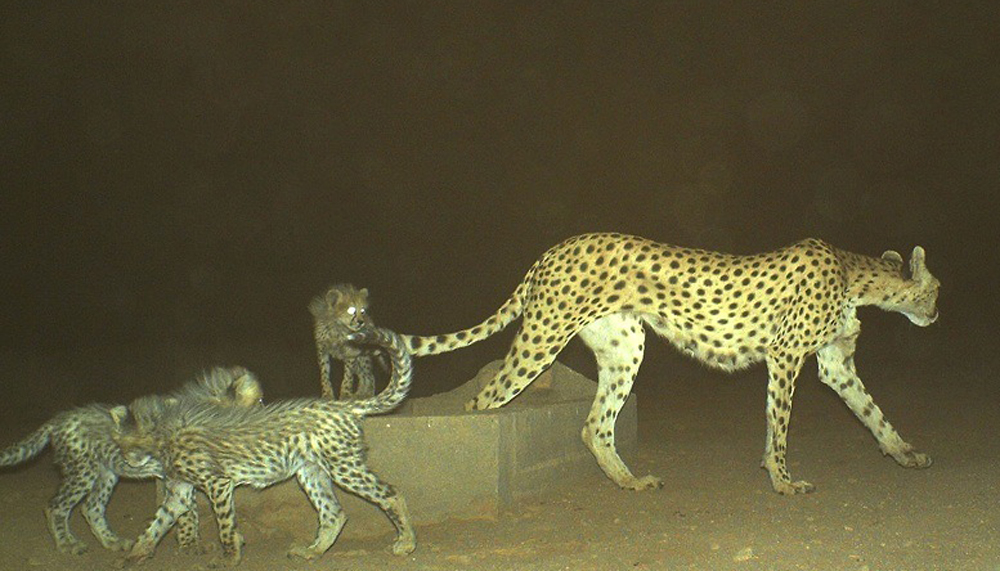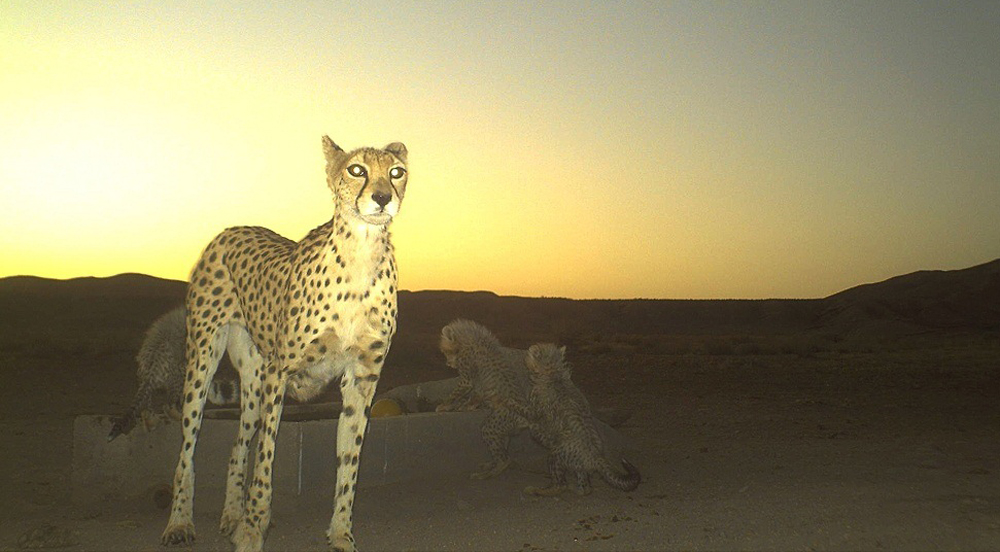Saving The Desert Cheetahs Of Iran
With just 50 of their kind left, Asiatic cheetahs find an ally in legendary field biologist George Schaller.
By Vicki Croke
Smaller and even thinner than African cheetahs, Asiatic Cheetahs, like this one in Naybandan Wildlife Refuge, are now found only in Iran. Today, among their top threats are cars, dogs, and gazelle poachers on motorcycles. Photo: IR DoE/CACP/WCS/UNDP.
It was a call on a cell phone from a herdsman in Iran saying, “There are some carnivores chasing some gazelles near us!” that tipped off George Schaller. Schaller’s team, including the herdsman’s son, raced a short distance by car across the scrubby desert terrain to the edge of the Miandasht reserve at the northeast corner of the country.
When they located the herder riding his donkey, he pointed to a spot about 300 yards away from his goats and sheep. Schaller, squinting into his binoculars, saw three of the rarest, most critically endangered cats on earth—the animals he had come here to help, but never expected to see, since even rangers rarely glimpse them—a mother Asiatic cheetah and her two large cubs.
This mother cheetah and her cubs were observed by George Schaller in February, on his last day in the field before returning to Tehran. “That was a real gift from nature,” Schaller says. Photo: H. Harati.
Their sand-hued, spotted coats, lighter in color than those of the African cheetah, seemed at moments to practically erase the family from the desert background. “It’s very strange,” Schaller says, “because they’re very pale animals in a plain habitat of short shrub. So, it’s almost like a vision.”
That mirage-like image underscores the story of a sub-species that has nearly vanished over time. Once plentiful from the Middle East to India and central Asia, they are needles in a haystack now—with an estimated 50 wild Asiatic cheetahs alive today, spread thinly over thousands of miles of harsh terrain in and around the central desert of Iran.
George Schaller in a wildlife refuge in Iran. Schaller says that spotting the cheetahs on this trip was “pure luck,” but the distinguished scientist has a history of remarkable field observations—during a 25-year period, he was one of only two Westerners to have seen a snow leopard in Nepal. Photo: Luke Hunter.
They are smaller and even thinner than African cheetahs. And in the colder climate, they can grow a more substantial coat, giving them a more “fuzzy” look, and, as Schaller says, they can “even have a little mane.”
They are in bigger trouble than the more numerous African cheetahs whose population stands at something like 10,000. Still, Schaller says that the Iranian government is committed to saving these cats from extinction, and he wants to help make that happen. If anyone can, it’s George Schaller.
Highlights from camera trap footage of the Asiatic cheetah taken by Panthera in cooperation with other groups. Video: ICS/DOE/CACP/PANTHERA.
Wildlife rainmaker. Fixer. Miracle worker. For decades, Schaller has done some of the earliest and best studies of mountain gorillas (pre-Dian Fossey), lions, tigers, giant pandas, and, as fans of Peter Matthiessen’s classic book featuring Schaller know, snow leopards.
Schaller, the most respected field biologist of our time, has conducted studies in some of the most forbidding landscapes on the planet, and been invited into countries or areas where few other Americans are welcome.
This time around, he’s working with two conservation groups he’s long been associated with—Panthera, the global wild cat conservation organization, and the Wildlife Conservation Society. They are among the very few American conservation NGOs allowed into Iran, and they cooperate with the Iranian Department of Environment as well as local NGOs.
George Schaller, working with Panthera and the Wildlife Conservation Society in Khar Touran National Park in Iran. Photo: Luke Hunter.
Schaller has made five trips to cheetah habitat in Iran, starting in 2000. His most recent one in February, was his first in 10 years and he seems to be making up for lost time.
His mission—to reassess the current state of these cats and the conservation efforts to save them—is an urgent one. As he says, “What I’ve been working on with my Iranian co-workers is what they need to do right now.” It was last month that he hit the ground running. Traveling with Iranian biologists and conservationists, he canvassed several parks and reserves in and around the great central desert of Iran, and was quickly able to draw up a punch list for cheetah survival: Cars, dogs, and gazelle poachers on high-speed motorcycles head up a list of threats.
An Asiatic cheetah mother and her three cubs in Miandasht Wildlife Refuge, the place where George Schaller would later observe a cheetah mother in daylight. Photo: IR DOE / CACP / ICS / PWHF / PANTHERA.
Cheetahs in Iran are spread out over a large, harsh habitat, and camera trap evidence shows that they sometimes travel 100 miles between reserves—often having to cross highways or roads. Half of all Asiatic cheetahs who die each year are killed by cars. “Cars speed like mad,” Schaller says, “and in one area they killed two females and two cubs within a 15 kilometer stretch.”
The solution is wildlife overpasses and wildlife corridors between parks, and to enforce regulations to slow vehicles down in critical crossing areas. Schaller, who works closely with Houman Jowkar, the head of the Conservation of the Asiatic Cheetah Project, says, “the government is seriously planning on that.”
Within the parks, there are other threats. Cheetahs are the fastest land animals and famously can reach speeds of up to 75 mph. But they are left in the dust when it comes to losing their favorite prey to poachers on souped-up motorcycles. Schaller says that men on powerful bikes “roar through the nature reserves, chase the gazelles till they exhaust them, then take them home and eat them. And gazelles are the main cheetah food.” Park guards, riding “slow, old Suzuki motorcycles” don’t have a chance of catching the culprits.
Asiatic cheetahs can have longer coats, look a little “fuzzy,” and some even have scraggly manes. Photo: IR DOE / CACP / ICS / PWHF / PANTHERA.
In his field report, Schaller notes the toll this can take, “In the Kalmand reserve near Yazd the gazelle population declined from about 2,000 to 200 within a few years.”
Then there are the dogs. Cheetahs are built for running not brawling. And they are vulnerable to the large, powerful, and often nearly feral mastiff-type dogs who accompany herdsmen into parks. Schaller says it is known that five cheetahs have been killed in the past three years by these dogs. And he argues that the dogs are unnecessary to the shepherds—they don’t actually herd sheep and goats, and they are not needed to protect the flocks since the shepherds are always with them. “Dogs should be completely banned from national parks and wildlife refuges,” Schaller writes.
“Unless they solve this issue,” Schaller says, “they’re going to lose their cheetahs. And, in fact, I’m not even sure what to do with some of these areas which have so few cheetahs that the death of even one has a huge impact.”
Asiatic cheetah mother and her three cubs in Miandasht Wildlife Refuge. These animals, says Schaller, are something that “no picture, no scientific paper can replace.” Photo: IR DOE/CACP/ICS/PWHF/ PANTHERA.
Is captive breeding the answer as some have suggested? Schaller doesn’t think so. Cheetahs breed poorly in captivity, though clearly there have been successes, often at zoos, but there are also so many difficulties associated with reintroducing captive-bred animals to the wild. More than that, Schaller notes, wild cheetahs would have to be captured to even start a captive breeding program. And there are so few Asiatic cheetahs left, “you can’t afford to take any out of the wild—then there would be less in the wild.”
Having more cheetahs in the wild, of course, is the goal. And that point was poetically driven home for Schaller on his last day in the field in Iran. It was then, with just hours left till he headed back to Tehran, the capital, that he was able to watch the mother cheetah and her cubs from a respectful distance.
“That was a real gift from nature,” Schaller says. Seeing the cheetahs in person is something that “no picture, no scientific paper can replace.”








16 Responses to “Saving The Desert Cheetahs Of Iran”
Thank you for posting this alert for preservation of these magnificent animals. There must also be an urgent call for protection of Iranian leopards, another beautiful animal on the road to extinction. Please help them.
Thank you for posting this alert. I hope the government would act on the recommendation.
agreed
The biggest problem of Iranian preservation of wildlife is lack of education and then it is lack of full government support. The situation is so bad that a park ranger was almost killed by a religious law called “Ghassas” (which is based on an eye for an eye concept) because he was doing his job protecting the park when several poachers not only did not obey his orders to leave the area but started shooting the rangers. One of the poachers later died in the incident.
It is note worthy that Iran’s ministry of environment and wildlife protection issues hunting licences not only for the locals but foreign hunters who pay high fees to hunt and kill rare animals that they are prohibited to hunt in their own countries namely, the US, Russia and Spain to name a few.
Iran does not value wildlife protection, period! The only thing that may change this situation is an international uproar. After all, Iran’s wildlife or any other country’s wildlife belong to the world and the future generations and its protection is a must!
Thank you for this story.
Too many species are in dire peril; let’s not wait until they are all nearly gone before something is done.
We would need to expand on both educating the public as well as placing pressure on the Iranian government to do a better job of protecting their national heritage and wildlife. Articles like these would need to be printed in Parsi by Iranian press and discussed on Iranian TV.
Organizations like Panthera are true champions for big cats worldwide. The best chance the Asiatic Cheetah has for survival is men like George Schaller and Luke Hunter who, along with team co-founder Dr. Alan Rabinowitz, are blazing a trail form every corner of the planet, opening the eyes of people from all walks of life. The men and women behind Panthera and other non governmental organizations (like Cheetah Conservation Fund’s Dr. Laurie Marker) have dedicated their lives to fighting for these amazing cats and it is about time the people of Planet Earth come together, regardless of their differences. Every species of plant, animal, and insect is connected to each other and to us. We are all part of the same web; the web of Life.
Thank you. Thank you. Thank you.
Thank you for your consideration about Iranian cheetah and this useful article.
Sepehr, from Iran
I am happy and thankful that someone like Schaler took an interest in the asiatic cheetah, but also depressed and discouraged that our own government and people don’t care enough to preserve nature and wildlife.
Thank you for all your efforts & hard work, cheetahs have to be helped to breed in the wild, unfortunately I have witnessed very brutal treatment by some Iranian agents in the case of protecting Iranian zebras, I am sure you are far more professional & caring . While I agree it has been the general disregard by the public in Iran to wild life & indeed the nature which has lead to the present critical state, I believe there are signs of reversing this trend . The issue of giving right to shoot to the rangers is a very complex legal dilemma, what is needed is more education & comprehensive program for public care.
incredible effort to save these magnificent beauties, is there a way to help financially and otherwise to assist the organization?
I am very sad because of few no of iranian cheetah remaining in wild.l want to save the cheetah with participating to you
To save Asiatic Cheetah..the government of Iran should share some of it with country like India who have good results in bringing back Asiatic Lion n Indian Rhino from near extinction..
sir, you are doing a great job…may god bless you
To save the Arabian cheetah, Indian cheetah, Iraqi cheetah the Persian cheetah or whatever humanities ego chooses : all of the people that faulted this beautiful animal out of its home must jointly unite and give it back what we took before it’s too late. Whatever spats us human have about its name or anything else is secondary. The cheetah really doesn’t care about the passport, just it’s habitat . We in Kuwait will work our best efforts to push for its salvation after fully recognizing we are all to blame for this grave and critical loss of an evolutionary marvel.
Comments are closed.